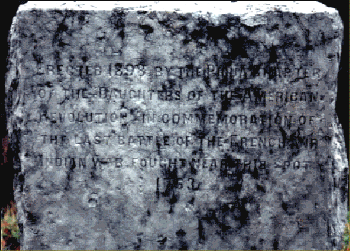|
The French & Indian War
Within two years of the Pickawillany attack, the French and Indian War began. The French marshaled their Indian allies, the
English organized theirs, and the battles began with the ‘Ohio Valley’ (Ohio,
Indiana, Illinois) and the rest of the territory, the prize. The traders on both
sides had needed the help of the Indians to get the furs they wanted, but the British and
French had treated the natives differently. The French traded more fairly and did not take
land for farming like the British did. Subsequently, when the war began, most of the
natives helped the French.
The British General Edward Braddock, with a force of 2,000 men, set out to capture Fort
Duquesne (today the site of Pittsburgh), at the forks of the Ohio River. Ten miles from
the Fort, he was ambushed by a coalition of Indian tribes, allied to the French. Braddock
lost four horses from under him before he succumbed to his wounds. Almost half of his men
died on that day. One of the survivors, his aide-de-camp, was a 23 year old major named
George Washington.
For almost three years the English seemed to be losing the war as devastating attacks
by Indians, including some who had switched sides, took their toll. But then, the fortunes
of the English improved; victories came along with the defeat of the French at the Battle
of Quebec. The signing of the Treaty of Paris in 1763 gave the English all the lands east
of the Mississippi River, including Ohio, and all of Canada. The Delaware and Shawnee
continued to fight the British through 1764; signing a formal treaty of peace in July
1765.
Although the French and Indian War ended in 1763, that same year saw a bloody battle
fought at the old Pickawillany Fort and Indian village site defended by the Miami Indians,
their Indian allies and remnants of French resistance against an attack by the Shawnee,
including Chief Blackhoof, their Indian and British
allies. The besieged fort stood its ground for over a week, before the attackers retreated
and left the area after suffering severe losses. Historians cannot agree on whether the
battle was the last gasp of the French and Indian War or the beginning of Chief
Pontiac’s conspiracy, a two year war of death and destruction against the British
military and white settlers. Pontiac’s War ended with a treaty in 1765.
In 1898,
the DAR installed a marker to commemorate the ‘last battle of the French and Indian
War’ fought at Fort Pickawillany on Hardin Road. After turning from SR 66 north onto
Hardin, it is within 1/2 mile, on the left-side, at the junction of Hardin Road and Hardin
Alternate Road.

'Indian' segment written in December, 1997 by David Lodge
[ Back to Indians Index ]
|

